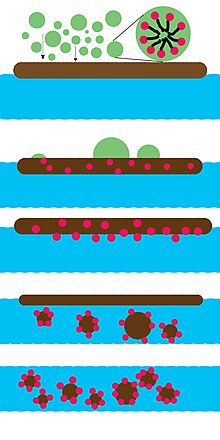
An oil dispersant is a mixture of emulsifiers and solvents that helps break oil into small droplets following an oil spill. Small droplets are easier to disperse throughout a water volume, and small droplets may be more readily biodegraded by microbes in the water. Dispersant use involves a trade-off between exposing coastal life to surface oil and exposing aquatic life to dispersed oil. While submerging the oil with dispersant may lessen exposure to marine life on the surface, it increases exposure for animals dwelling underwater, who may be harmed by toxicity of both dispersed oil and dispersant.[1][2][3] Although dispersant reduces the amount of oil that lands ashore, it may allow faster, deeper penetration of oil into coastal terrain, where it is not easily biodegraded.[4]
- ^ "Treating oil spills with chemical dispersants: Is the cure worse than the ailment?". Retrieved 7 April 2014.
- ^ "Dispersants EPA.gov".
- ^ "Dispersants". Center for Biological Diversity. Retrieved 6 April 2014.
- ^ "Study: Dispersants Can Move Hydrocarbons Faster and Deeper into Gulf Sand". 2013-05-10.